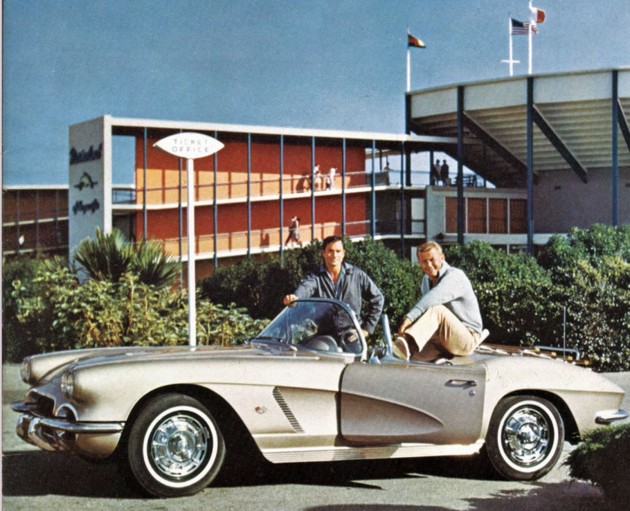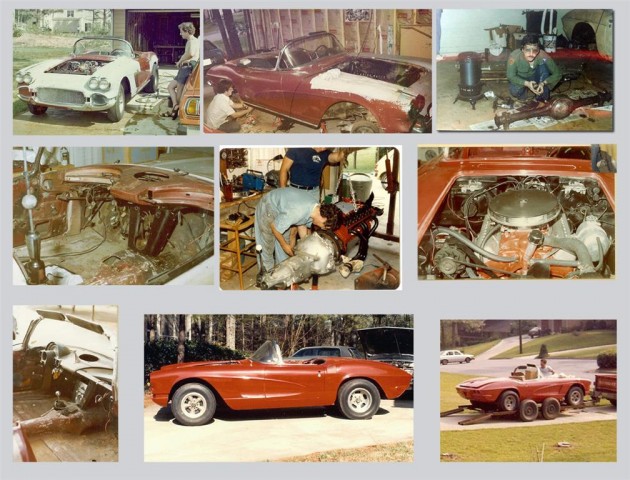Restoring cars is not an investment: it is a hobby. Chasing a dream car is not for the poor or faint of heart. I guess every boy had a dream car that he swore that he would one day own. I know I certainly had mine. The Corvette has always been on my dream list since it initial introduction in 1953. But in 1960 the dream was cemented into my gray matter by a TV show that featured two guys traveling across the country in a Corvette. Each year they would have a new Corvette from 1960 to 1964.
Route 66 TV Series.

I guess everyone who was an actor in the 1960s appeared on this show. I do not remember much about the show with the exception of the cars. I had a subscription to almost every car magazine published at the time. To make matters worse, my brother bought a 1959 Corvette in 1961. Even though he was five years older than I was, the rivalry was still very much alive.
Just like the Beatles destroyed music when they came here from England, Chevrolet destroyed the Corvette with the Stingray design which removed the Side scallops from the "Vette". That made the 1962 Corvette my dream car. I was seventeen years old in 1962 and driving a 1953 Studebaker station Wagon.
I eventually overcame my resistance to both the Beatles and the later Corvettes, but the 1962 was still my all-time favorite. I knew I would eventually own one.
Flash forward until 1978. I was now married and most of my wild days were behind me. I would not be traveling around the country in the carefree life that Buz and Tod did. But the dream car was just barely within reach. One day I was making a sales call in Covington, Georgia and passed a farmhouse. There in the barn sat a 1962 well-used and abused Corvette. I stopped and knocked on the door. I guess the farmer was not used to traveling salesmen knocking on his door to ask about the car in the barn. I never got around to asking if he had a daughter, I was interested in the car.
We made the deal and I told him I would be back that weekend with the money ($1500 I think) and a trailer to pick up the car. I might add that this was before I learned to get approval for a major purchase from the boss, but I must admit she took it well. I think I was still in
husband to be training at the time.
When you take on a restoration project, there are two decisions you need to make. Do you want a matching numbers care authentic down to the minute details, or do you want a cool hot rod where you can apply your personality. The answer is simply a matter of money. Authentic restoration is expensive. I found out later that Hot Rod restoration is also expensive.
We had just purchased our first house and the garage became the workshop for my project. I think the boss approved since I put the Vette in the middle of the garage, which meant her car, was in the driveway. I decided to do the restoration in two stages. First, I would get the car drivable as is and then a complete rebuild after I had satisfied my dream of owning a drivable 1962 V.
Over the next few years, I spent every spare minute and dollar in rebuilding the car. Corvette parts were expensive then. Normally you would think you could find parts for a sixteen-year-old car in any junk yard. Not if it is a Corvette. After some non-internet research, I found out that the 1953-1962 Corvette was based on the 1953 Chevrolet sedan. Almost all of the chassis and brake parts were the same. With list in hand, I headed for various junk yards in search of parts for my 1953 Chevrolet Sedan.
After many hours, the car was ready for the engine work. The 1962 Corvette had a 327 cubic Inch V8 that came in several variations. There was a fuel injection version and a several four-barrel versions. Since a fuel injection unit was around $1200 itself, I chose the next powerhouse down; a 327 -340HP with high compression pistons. It would be a complete rebuild with new pistons, rods, valves etc.
The existing motor block was in good condition so I had the basics of the engine build. Unfortunately, the block would be the cheapest thing in the build process. There was a saying back in the day for us would be hot rodders.
"If it won't run, chrome it". The project had already passed my estimated budget by several thousand dollars and I still did not have a completed derivable car. It was derivable but not street legal yet. Although I had most of the parts, time and money were still an obstacle.
That is when life and dreams came to the intersection. As Yogi Berra said when you come to a fork in the road "Take It". My daughter was born in 1980 followed by my son in 1981. The
husband in training routine had worn thin with the boss and the decision was made to sell the Corvette. I knew a Falcon Football player who had just signed with a bonus, (the name escapes me now) and he expressed an interest in the Corvette. We made a deal and I arranged to trailer the car to a professional restorer where it would be finished.
I could never make my register ledger tally up to show a profit on the project. No matter how I tweaked the numbers, I came our as a loss. That is when I had an epiphany. It was simple; I would count all the tools and shop equipment that I had bought in a separate category from the actual car expenses. ``I sill had a loss in the project but at least I could say that the tools and equipment were an investment which would pay off later. My wife, who never had an accounting course in her life, made the observation that the tools and equipment were just another carrot for a future money losing restoration. I was allowed to keep the shop equipment but it had to be moved to one side of the garage (my side) and her car would never again be parked in the driveway again.
As a matter of consolation, I ran across a 1960 Bugeye Sprite and with her approval (I am not that slow of a learner) I bought it for a future restoration project for my son and I. The Bugeye Sprite sat in the garage of my first and second house until my son turned fifteen. Then the fun began again with my son's help.
Perhaps, I will write a story about the restoration of the Sprite. It too was sold when my son went to college and the money donated to him for his use. He bought a 1969 barn find Mustang and the saga continued. I think that the men in my family are slow learners. The Mustang restoration is the same song but a different verse.
The Corvette was an exercise in self-centered gratification, but the Sprite was a project for father and son from the day I bought it. In my mind, I was not restoring a Sprite but raising a son. My son's Mustang project was a repeat of self-centered gratification but he just had his first child. He is already talking about the project he has in mind for he and Sully.
Stay tuned, this song may never end.
 Click here for an enlarged version of above picture
Click here for an enlarged version of above picture
Additional Pictures and specification site:
Another construction picture
The Dream Continues -1998 Mustang project
1962 Corvette Specifications


 Click here for an enlarged version of above picture
Click here for an enlarged version of above picture